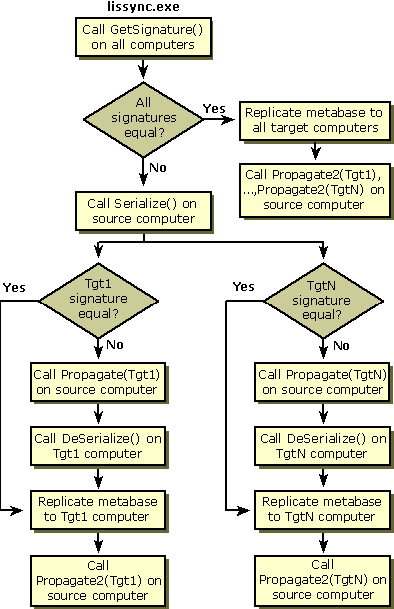Replicating to Target Computers
When replicating to one or more target computers, Iissync.exe processes each target computer independent of the others. This means that different target computers can be in different steps of the replication process at the same time.
Your DCOM replication extension interface must be developed as detailed in the IMSAdminReplication Interface Reference section. It must also be registered with IIS as a custom administration extension, as explained in Developing Administration Extensions. Your new interface must be installed on all source and target computers.
The following diagram illustrates what events occur when a single source computer is replicating to one or more target computers:

- Iissync.exe calls GetSignature on the source and target computers. Both computers calculate and return custom signatures that represent the state of the configuration data and other data that is to be synchronized.
- Iissync.exe compares the two signatures.
- If the two signatures are the same, Iissync.exe replicates the metabase and then calls Propagate2 on the source computer, identifying the target computer and providing a flag that indicates that the signatures were the same. Your program on the source computer can then perform any termination tasks you require.
- If any target computer's signature differs from the source computer, Iissync.exe calls the source computer's Serialize method once. Your program returns data to Iissync.exe for presentation to all target computers that have different signatures. Iissync.exe also calls the Propagate method on the source computer once for each target computer with a signature mismatch. The data returned from the source computer's Serialize method is presented (by use of the DeSerialize method) to those target computers that have different signatures.
Note DeSerialize will not be called on the target computer if either the Serialize or Propagate method returns an error that causes replication to be terminated.
- Iissync.exe then calls Propagate2 on the source computer, identifying the target computer and providing a flag that indicates the signatures were not the same. Your program on the source computer can then perform any termination tasks you require associated with this target computer.
Note Replication to multiple target computers is not sequenced. You should not make any assumptions when designing your program in regards to the order in which target computers are selected for replication. Your GetSignature method is called first. On the source computer, calls to other methods can be received multiple times in any order.

